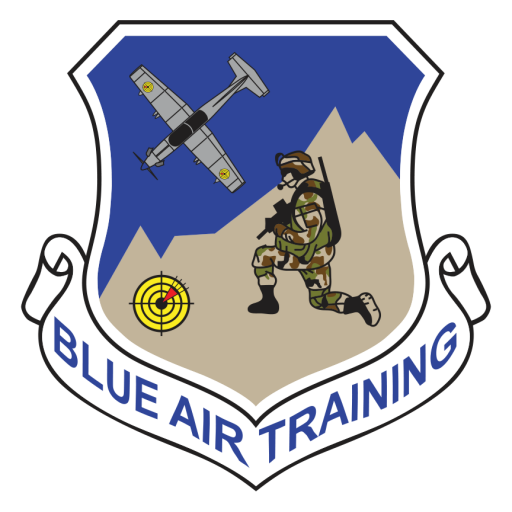Close Air Support (CAS) is not always intrepid aviators swooping in to drive out the bad guys and protect the good guys, that is, it is not just an emergency procedure to protect potentially trapped soldiers, it is also an operational tactic to enhance the performance of ground forces.
Lt. Col Callahan’s account of the 1969 Khe Sanh battle for Hill 861 provides an example of CAS from Vietnam.
“Because Hill 861 (near the southern perimeter of Khe Sanh Combat Base) had proven so deadly to the two companies that attacked on 25 and 26 April, 2nd/3rd (2/3) battalion’s attack for 27 to 28 April was preceded by a tremendous volume of supporting arms. The preparatory fires included 764,700 pounds of aviation ordnance and more than 1,800 rounds of artillery of various calibers. While two B-52 “ARC LIGHT” strikes were delivered further to the north and west of Hill 861 to discourage the North Vietnamese Army (NVA) from reinforcing the Marines’ objective, the vast majority of the ordnance was delivered by tactical aircraft, especially those of the 1st Marine Air Wing, holding in huge stacks until they could be sequenced in to attack Hill 861 under the control of both Marine and Air Force FAC(A)s.

An A-4 drops two “snake-eye” bombs on a target close to the southern perimeter of Khe Sanh Combat Base in 1968. (Photo Robert Donoghue. Close Air Support and the Battle For Khe Sanh, Lieutenant Colonel Shawn P. Callahan, U.S. Marine Corps, 2009, p. 47)
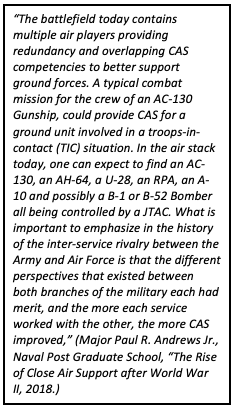
“The FACs working over the objective developed a new technique for locating and destroying the enemy bunkers which had sheltered the NVA from the Marines attacking the hills on the previous days. CAS aircraft were directed to deliver 250-pound and 500-pound high-drag “snake eye” bombs in long “rippled” strings from low angle dives, stripping the hillside of trees and heavy foliage to expose the well-camouflaged bunkers. Once the bunkers were located, tactical aircraft delivered heavier ordnance, including 750-, 1000-and 2000-pound bombs, from more precise high angle dives to destroy the bunkers themselves. All of this was concentrated on a piece of terrain of approximately one square kilometer in size. It is little wonder, therefore, that on the 28th, when 2/3 launched its attack up Hill 861, it found the objective, with its 25 bunkers and more than 400 fighting holes, completely unoccupied. Without losing a single Marine, 2/3 captured a hill that had cost 39 Marines their lives just a few days earlier. The victory was an obvious triumph of supporting arms, especially the destructive power of fixed-wing close air support.” (Close Air Support and The Battle for Khe Sanh, Lieutenant Colonel Shawn P. Callahan, U.S. Marine Corps, 2009)
Close Air Support – A Brief History
CAS can take on many forms—it is not just highly maneuverable aircraft sweeping in on targets with pinpoint accuracy to take out a machine gun nest. Some historians trace CAS back to World War I when pilots flying fabric covered biplanes flew over enemy trenches dropping bombs over the side of the aircraft by hand.
CAS became a more coordinated effort in World War II when ground forces could communicate directly with aircraft and direct them to a specific enemy position.
One early example of the use of Terminal Air Controllers (TAC) to direct USAAF air strikes occurred during the breakout from Normandy. Gen. Pete Quesada, Commander of the IX Tactical Air Command supporting the U.S. First Army equipped several tanks with Air Force radios and replaced the tank’s loaders with fighter pilots to serve as a forward air controller (who was also taught to perform loader duties). These special tanks were positioned near the front of attacking columns, allowing FACs to direct P-47 aircraft and other fighters against German forces impeding the Allied advance.
This all changed in 1947 when the U. S. Air Force was created as a separate major command, and essentially assumed control of most flight operations that had previously belonged to the Army (except for support helicopters and liaison aircraft). The Air Force vision was strategic, focusing on long range bombing capabilities and air superiority through fighters. The Korean War was the crucible out of which true CAS doctrine would eventually be forged.

In 1957, the Secretary of Defense assigned the role of all CAS to the Air Force, directing them to meet the CAS requirements of the Army. Despite clear orders, the contention continued throughout the 1960s into the Vietnam conflict. The Air Force concept of CAS was fast aircraft operating under the command of the Tactical Air Control System. The Army wanted organic air assets directed by the ground forces that needed their support, for quicker, more precise responses.
The Air Force and the Army eventually developed improved CAS doctrines based on lessons learned from WWII, Korea, and Vietnam, leading to today’s Joint Terminal Attack Control (JTAC) approach.
CAS Today
CAS can be applied almost anywhere, and anytime friendly forces are threatened by enemy forces. Threat is more of a determining factor than proximity. Today, each service trains as part of a joint force, and several types of aircraft may be designated for CAS roles, including both fixed wing (FW) and rotary wing (RW) aircraft.
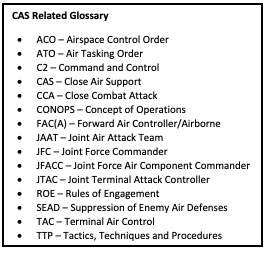
Understanding the Terminologies
Modern CAS depends on a joint understanding of the roles, responsibilities, and capabilities, of each service.
The “controllers” are the key link between the ground unit commanders and both higher authorities (that may have to approve a CAS action) and the attack air crews. The Joint Terminal Attack Controller (JTAC) or Forward Air Controller/Airborne (FAC(A)) are recognized across all services as authorized to perform Terminal Attack Control (TAC).
CAS enables commanders to attack targets that ground forces would otherwise not be able to engage. CAS provides ground commanders with the ability and flexibility to strike the enemy swiftly and unexpectedly.
Each commander must understand the current situation and attack planning criteria. Criteria include the immediate mission and CONOPS; enemy composition, strength, and position(s), capabilities of available CAS assets; and rules of engagement, to mention only a few.
As seen in the Khe Sanh event, FAC(A)s or JTACs work with ground commanders to develop a mission objective. The air controllers then determine the plan and munitions needed to accomplish the commander’s objective. Aircrews are responsible for recommending weapons and tactics. Following an attack, JTACs, FAC(A)s, and CAS aircrews assesses battle damage to determine mission effectiveness.
Types of CAS Assets
Both fixed wing (FW) and rotary-wing (RW) aircraft may be deployed on CAS missions.
FW assets are primarily provided by the Air Force or the Navy. The Air Force A-10 is designed specifically for CAS, but multi-role F-15s, F-16s and F/A-18s also fly CAS mission sets. The fact is, almost any fixed wing combat aircraft can contribute to a CAS mission, based on specific requirements (for example, the B-52 “Arc Light” mission at Khe Sanh).
RW helicopters can maneuver and reposition quickly in response to changing battle conditions. Their maneuverability allows them to follow the flow of combat, hover, and reposition as conditions require. Combat helicopter are armed with a variety of weapons, including mounted cannons, helmet sighted guns, rocket launchers, and manned machine guns. They may also be equipped with counter measures to protect themselves from heat-seeking or radar guided missiles.
RW Army Air Calvary are considered part of the ground forces to which they are assigned, and their mission is described as close combat attack (CCA) rather than CAS. When working with their assigned units, they do not necessarily use CAS tactics, techniques, and procedures (TTP) unless assigned as part of a CAS operation.
Marine Corps attack helicopters are typically integrated into the Marine Air-Ground Task Force (MAGTF) and are trained and equipped to perform CAS missions.
The Role of Unmanned aircraft
Unmanned aircraft (UA) now called Remotely Piloted Aircraft (RPA) are being integrated into CAS operations. They offer the ability to collect intelligence and locate targets. They are quieter and much smaller than manned aircraft and although less survivable in high threat scenarios, they do not put aircrews at risk. The primary benefit to RPA’s in the CAS mission is their exponentially longer loiter time than manned CAS aircraft. This ability to loiter provides intelligence and “patterns of life” assessments which are an integral part of the mission planning. RPAs can also be used as target designators or communication relay stations between JTAC, aircraft, and command posts, and as intelligence sensors. Armed RPAs, often controlled from positions far from the battleground, can be directed by JTAC.
Keys to Successful CAS
Effective CAS operations depend on thoroughly trained personnel, effective planning, clear communications, command, and control, target designation, access to the appropriate ordnance, and streamlined and flexible procedures in order to have detailed integration of air assets into the ground scheme of maneuver.
Flexible procedures for CAS have been developed to speed the response of CAS aircraft to JTAS/FAC/A requests for strike. This is achieved by staging CAS aircraft at forward operating bases or having them loiter near an operations area. Quick, unexpected (by enemy forces) action by CAS enhances its effectiveness.
Target marking by UA or manned aircraft improves CAS effectiveness. Targeting can be accomplished by simple smoke flares or laser designators for high-tech missiles and bombs.
The type of ordnance to be deployed is critical for the success of the mission. As in the Khe Sanh mission, using one weapon to clear and expose the battlefield made offensive anti-troop weapons more effective.
Environmental conditions add an additional layer of complexity to the CAS mission. Weather and darkness influence both the ability to fly CAS strike missions, and the ability of JTAC/FAC/A to collect accurate information. Specially equipped aircraft and unmanned aircraft can aid planning in adverse conditions by being able to locate probable targets through remote sensing techniques (infrared video, radio emissions, etc.)
FW aircraft can operate above blowing dust or dense ground fog that would render RW aircraft ineffective, while RW can operate under low ceilings that would prevent FW operations.
Responsibilities
The JFC establishes guidance and priorities for CAS in CONOPS, campaign plans, and when assigning capabilities and forces to components.
Authority to accomplish missions and tasks is assigned to Joint Force Air Component Commander (JFACC). JFACC recommends air apportionment decisions, allocates forces/capabilities, creates and executes ATO and coordinates with other component commanders.
Minimizing Fratricide aka “Friendly Fire”
Combat in close quarters involving moving enemy elements, high speed aircraft, changes in battlefield conditions (weather, visibility, etc.) can cause misidentification of targets, loss of position awareness, inaccurate target locations, etc., that can cause weapons to be misdirected, resulting in casualties among friendly forces or non-combatant civilians. The use of mitigating strategies – detailed planning, standardized procedures, realistic training/mission rehearsals, friendly tagging or tracking, effective FAC and/or AO and ALO coordination, and sound clearance procedures can significantly reduce friendly fire incidents.
What Planes Provide CAS?
CAS aircraft fall into two broad categories, FW (airplanes) and RW (helicopters). Note that modern warfare may also use unmanned Remotely Piloted Aircraft or Vehicles (RPA or RPV) of both fixed and rotary wing types, with capabilities similar to their manned counterparts. As mentioned, almost any combat aircraft or RPV can become a CAS asset based on the situation.
Although not as fast as FW aircraft, attack helicopters can maneuver at lower altitudes, hover, and “pop up” and quickly deliver rockets and shells on an unaware enemy. Hovering and maneuverability allow them to stay on station longer than FW aircraft. Key military rotorcraft available for CAS missions include:
AH-64 — Apache, the army’s primary attack helicopter, armed with the chain gun, Hellfire missiles, and Hydra 70 rocket pods and a crew of two.
AH-1 – Cobra Attack Helicopter, used largely by the Marine Corps, is armed with missiles and a gun.
UH-60 — Black Hawk, perhaps the most versatile helicopter in the military. Designed as a troop transport helicopter, it can carry troops into and out of the battle zone, carry artillery pieces slung under the aircraft, and can be outfitted with an array of weaponry for use in combat operations.
MH-6 — Little Bird is a light observation helicopter that is also equipped for interdiction, assault, and light transport. It would be suitable for FAC/A use.
Fixed wing aircraft deliver a separate set of capabilities in the CAS mission. Their speed allows them to quickly deliver any combination of gun fire, missiles and rockets, and bombs. No discussion of CAS can be complete without the mention of the Air Force’s A-10 Thunderbolt.
The A-10 Thunderbolt (aka Warthog) was specifically designed for the CAS role. The two-engine, single-seat attack aircraft can deliver a range of rockets, missiles, and bombs mounted on 13 pylons under the wings and fuselage. But its most effective weapon is an internally-mounted 30 mm cannon firing from the nose of the aircraft. The fact that it is mounted on the craft’s centerline means the gun is aimed wherever the aircraft is pointed. It is designed to fly low and provide precise delivery of its weapons on ground targets. The engines are mounted high on the fuselage to protect them from ground fire, and the pilot is surrounded by a heavily armored cockpit.

The A-10 Thunderbolt, (aka “Warthog”) flown by Blue Air CEO, James “Chef” Barlow, pulls off target after strafing at the Barry Goldwater range wearing a Blue Air patch on his shoulder.
In Operation Desert Storm, both AH-64 Apaches and A-10 Thunderbolts flew close air support missions. Although half as many A-10s were deployed as Apaches, they flew more than 12 times the number of sorties. The A-10 had more than 4000 confirmed kills, which was more than three times the number of credited kills for the Apache, and the A-10’s had a much higher operational readiness rate. (Close Call for Close Air Support? By Anil R. Pustam)
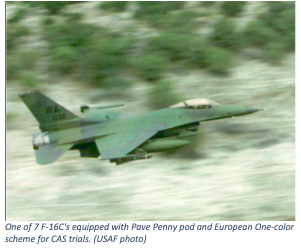
F-16 — Fighting Falcon “Viper” missions include ground attack with guns and bombs. While it lacks the “low and slow” capabilities of the A-10, it is equipped with sensors that can guide it precisely to ground targets and to deploy appropriate types of weapons.
During Desert Storm, several F/A-16s were equipped with a four-barrel GAU-13 cannon mounted in a centerline pod under the aircraft. However, the vibration from the gun firing was so intense that pilots had difficulty both flying the aircraft and aiming the gun.
F-15E – The Strike Eagle, like the F-16, the is multi-role fighter capable of ground strikes as well as air-to-air combat.
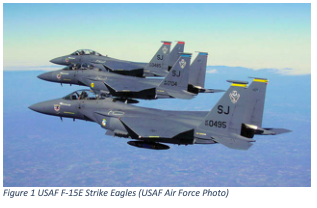 A Strike Eagle team, led by then Maj. Christopher M. Short, flew overhead during the early part of the Battle Robert’s Ridge in Afghanistan.
A Strike Eagle team, led by then Maj. Christopher M. Short, flew overhead during the early part of the Battle Robert’s Ridge in Afghanistan.
Short, who is now a brigadier general, said the lessons learned from their initial operations changed the fighter community culture as a whole and directly contributed to the advancement of Strike Eagle CAS training.
Short explained, “I went from a culture where the weapons officers would say, ‘We don’t do close-air support in this airplane,’ to the briefing starting out that the reason we’re going to Afghanistan is for that 18-year-old on top of the mountain with an M-16,” he said. They “did CAS.”
 F/A-18 – Super Hornet, flown from aircraft carriers, also flew CAS missions in Afghanistan.
F/A-18 – Super Hornet, flown from aircraft carriers, also flew CAS missions in Afghanistan.
The 20mm cannon on the F/A-18 is mounted right behind the radar, firing over the top of the antenna array. It is optimized for firing straight down aircraft centerline. While not as powerful as the A-10’s 30mm cannon, the 20mm, combined with accuracy is an effective ground attack weapon.
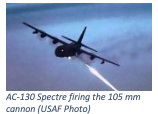 AC-130 – Spectre (right) and Spooky bear mentioning. These were modified C-130 transports, outfitted with 40mm and 105mm cannons, to support interdiction and CAS missions. The 105 mm cannon is mounted to fire out the side of the aircraft as it circled above delivering a blistering hail of rounds on the target.
AC-130 – Spectre (right) and Spooky bear mentioning. These were modified C-130 transports, outfitted with 40mm and 105mm cannons, to support interdiction and CAS missions. The 105 mm cannon is mounted to fire out the side of the aircraft as it circled above delivering a blistering hail of rounds on the target.
Both B-52 and B-1B strategic bombers flew CAS support missions in Vietnam and Afghanistan.
Other CAS Aircraft
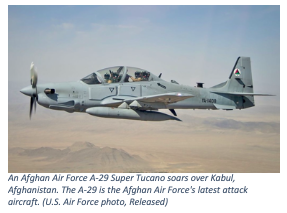 Smaller countries with smaller defense budgets have turned to smaller, less expensive aircraft for CAS and interdiction roles. From the late 1960s, the Cessna A-37, equipped with guns and rockets was operated by several smaller countries.
Smaller countries with smaller defense budgets have turned to smaller, less expensive aircraft for CAS and interdiction roles. From the late 1960s, the Cessna A-37, equipped with guns and rockets was operated by several smaller countries.
The A-37, long out of production, has been replaced by aircraft like the Embraer EMB Tucano. This two seat Brazilian turboprop can be armed with a variety of weapons including guns and bombs. Its weapons load and maneuverability make it an effective interdiction, CAS, or close attack platform.
Battlefield Air Interdiction?
Air Interdiction (AI) is similar to CAS except, usually there are no friendly forces in the immediate area. Cutting off roads, destroying bridges and railroads, and disrupting logistics and communications or forcing urgent movement can redirect enemy forces into more predictable, more vulnerable positions. While detailed planning is required, AI does not usually involve friendly forces in the target area.
CAS in Other Countries
In the late 1970s, the Soviet Union developed the Su-25 as a CAS aircraft. The S-25 more closely resembled the Northrop A-9, which the A-10 beat in the competition. The A-9 was faster than the A-10, but not as well armored. The Su-25 has been replaced by the Su-39; Russia considering both the Su-25 and the A-10 as obsolete. The Su-39 has improved navigation and electronic countermeasures (ECM) systems and can use precision guided missiles. Like the A-10, it is well armored. It is both highly maneuverable and can operate from undeveloped airfields.
Do CAS pilots also train for Air-to-Air?
The answer to this is “it depends.” Specifically, it depends on the type of aircraft involved. In the case of multi-role fighters such as the F-15, F-16, and F/A-18, pilots must be proficient in both air-to-air combat and air-to-ground attacks (typical of CAS operations), and they train for both. A-10 pilots train almost exclusively for CAS and similar low-level attack missions.
Is Contract CAS and Air Support Training Available
Several different agencies provide CAS and interdiction training. CAS training includes both JTAC and FAC/A certifications as well as CAS flight operations, and some offer training with live weapons. Training is conducted in both simulators and in aircraft. The objective is to recreate realistic scenarios to train for JTAC certification.
According to their website, “Blue Air Training provides the highest quality CAS for JTAC training in the industry and has done so for nearly a decade. Blue Air Training employs the world’s leading experts in CAS and JTAC training who have literally written the book on CAS Operations. In their previous Active Duty USAF careers, they played instrumental roles in authoring the JP 3-09.3 and J-FIRE field manuals, A-10 3-3 Tactics, Techniques & Procedures Manual and continue to be active participants in writing syllabi.
Blue Air Training is the only civil entity engaged with the 561st Joint Tactics Squadron and included in 6CTS, 57WG, and ACC WEPTACs to assist in developing and keep current USAF JTAC syllabus and doctrine.” (Blue Air Training)
Blue Air Training was established by CEO James “Chef” Barlow who, has more than 4,100 hours total time, including the A-10 (2000+ hours), as well as both F-16s and F/A-18s. He was an author on several joint tactical manuals that are still used today by CAS assets in all branches of the service.
Blue Air Training operates several types of aircraft including the A-90 Raider and the BAC-167 Strikemaster. The A-90 Raider was designed specifically for CAS and is effective for JTAC training.
A-90 Raider
The A-90 Raider is an optimally designed aircraft used for Close Air Support (CAS) training exclusively by Blue Air Training. The A-90 Raider is extremely effective as a JTAC training platform due its incredibly long endurance, upgraded communications, and the ability to carry weapons systems for realistic training.
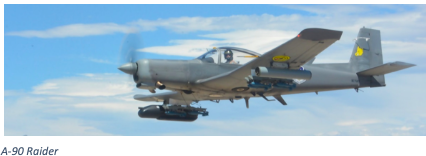
BAC-167 Strikemaster
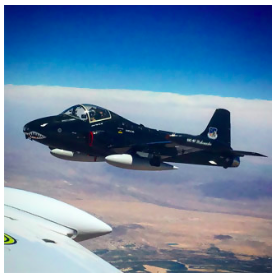 The British Aircraft Corporation BAC-167 Strikemaster is a two-seat, single engine jet aircraft. The Strikemaster is an impressive airplane with four hard-points, a service ceiling of 40,000 feet, and a maximum airspeed over 450 knots. Attached external fuel tanks provide a two-hour loiter time, while the FLIR 380HD Multi-Spectrum Sensor sees the laser designation during laser guided bomb simulated deliveries.
The British Aircraft Corporation BAC-167 Strikemaster is a two-seat, single engine jet aircraft. The Strikemaster is an impressive airplane with four hard-points, a service ceiling of 40,000 feet, and a maximum airspeed over 450 knots. Attached external fuel tanks provide a two-hour loiter time, while the FLIR 380HD Multi-Spectrum Sensor sees the laser designation during laser guided bomb simulated deliveries.
These aircraft are used to train JTACs. These highly-trained JTACs require certification before being able to deploy with their units overseas. Blue Air Training’s role in this training is to simulate close air support aircraft dropping BDU-33 practice bombs and shooting 2.75” live-fire rockets tasked by the JTACs from the ground.
Does CAS exist as long as there are ground troops?
The Air Force has suggested that it will decommission the A-10 and turn CAS roles over to F-15E and F-16 aircraft, or possibly develop an unmanned aircraft for the CAS role.
The Rand Corporation completed an analysis of future Air Force combat requirements and concludes that “Regardless of the outcome of the requirements reexamination process and the subsequent capabilities and cost-based analyses, we recommend fielding a viable replacement CAS capability before eliminating the capability the A-10 provides to minimize the risk to ground forces.” (https://www.rand.org/pubs/research_reports/RR1233.html)
Rand also concluded that while the Air Force seems to be focusing on “high-end” air threats (i.e., strategic strikes), that most U.S. military operations will likely continue occurring on the “low-end” against adversaries with limited, low cost anti-air capabilities for many years to come.” (https://www.rand.org/pubs/research_reports/RR1233.html)
It is hard to imagine, at least in the foreseeable future, military engagements that do not deploy ground forces in opposition to an enemy force. As long as that is the case, there will be an operational role to protect those troops on the ground with air power—CAS—with proven technologies and capabilities.
One Pilot’s Perspective
In a recent discussion, a Blue Air A-10 pilot related this story.
“There was one engagement that I was involved in, but I never fired a shot. I didn’t drop a bomb. I didn’t shoot the gun. But it was what we were there to do. There was a scout team on the ground that had taken some fire–there were only six or eight of them. Out scouting around they were about two and a half, three miles away from their little forward operating base.
“We got the call. And we had to find them. We didn’t know where they were exactly; we were searching for them. We had them on the radio and found out that they had been able to get away from the guys who were shooting at them. But, as they were heading back, they kept taking single shots near them, not a lot of fire, but still getting shot at. All they asked was that we just stay overhead, because the bad guys knew that if there’s an A-10 overhead and if we find them, they will die.
You could hear them breathing heavy on the radio. These guys were running. I mean, they were not walking. They were running.
We finally saw them. We could see them visually and in our targeting pods. They said, “Just stay overhead and scan the mountains around us. Make sure there’s nobody walking around with guns. Make sure there’s nobody here.”
It took 30 or 40 minutes with them running the whole time. They were loaded down—full packs, their weapons and their ammo.
They were moving…I mean, as fast as they could and keep everybody together. They didn’t want to string the whole line out or anything. They kept a small group together. They were just running down the mountain toward their forward operating base (FOB).
After about 40 minutes or so, we saw they were getting close to the FOB, hadn’t taken any more shots since we showed up. Then the guys inside the FOB saw them coming, and when they got close, opened the gates. They ran out, covered them. The guys got inside and just fell over. They were totally exhausted. They just fell over.
We got on the radio with them again, and they’re like, “Yep, we’re all here, all accounted for. We’re all good,” and then they all said “Thanks.”
We’re like, “Hey, that’s what we’re there to do.” We stayed overhead another 10 or 15 minutes just to make sure that the FOB wasn’t going to get attacked or anything like that. On the radio they confirmed, “Nope. We’re not picking up any radio chatter. We’re not seeing anybody. But if we need you, we’ll call you again.”
“All right.” We went home. It was just like, “Okay. Saving the guys on the ground is my job whether I fire a shot or not. All those guys made it back. They made it back.”
————————————————————————————————————-
References
… The A-90 Raider is extremely effective as a JTAC training platform due its incredibly long endurance, upgraded communications, and the ability to carry … a maximum airspeed over 450 knots. Attached external fuel tanks provide a two-hour loiter time, while the FLIR 380HD Multi-Spectrum Sensor with SWIR LST sees your laser designation during LGB
Close Air Support and The Battle for Khe Sanh PCN 10600090000_1
… primary air combat elements in this air-land bat-. 9. An A-4 drops two “snake-eye” bombs on a target close to the southern perimeter of Khe Sanh Combat Base…. enemy bunkers which had sheltered the NVA from the Marines attacking the hills on the previous days. GAS aircraft were directed to deliver. 250-pound and
Full text of “Close Air Support and The Battle for Khe Sanh”
… air combat elements in this air-land bat- AnA-4 drops two “snake-eye” bombs on a target close to the southern perimeter of Khe Sanh Combat Base. title: the 7th … CLOSE AIR SUPPORT AND THE BATTLE FOR KHE SANH lieutenant Colonel Shawn P. Callahan U.S. Marine Corps—A Front Cover
Our Services | Blue Air Training
… Blue Air Training is the only civil entity engaged with the 561st Joint Tactics Squadron and included in … 6CTS, 57WG, and ACC WEPTACs to assist in developing and keep current USAF JTAC syllabus and doctrine.
A-90 Raider | Blue Air Training
… The A-90 Raider is extremely effective as a JTAC training platform due its incredibly long endurance, upgraded communications, and the ability to carry
Close Air Support and The Battle for Khe Sanh [Illustrated Edition …
… Front Cover: An A-4 drops two snake-eye bombs on a target close to the southern perimeter of Khe Sanh Combat Base in 1968.-Photo Courtesy of Robert
This Is the Battle That Turned the F-15 Strike Eagle into a Legend
… A Strike Eagle team, led by then Maj. Christopher M. Short, flew overhead during the early part of the Battle Robert’s Ridge. “And so, we shot
